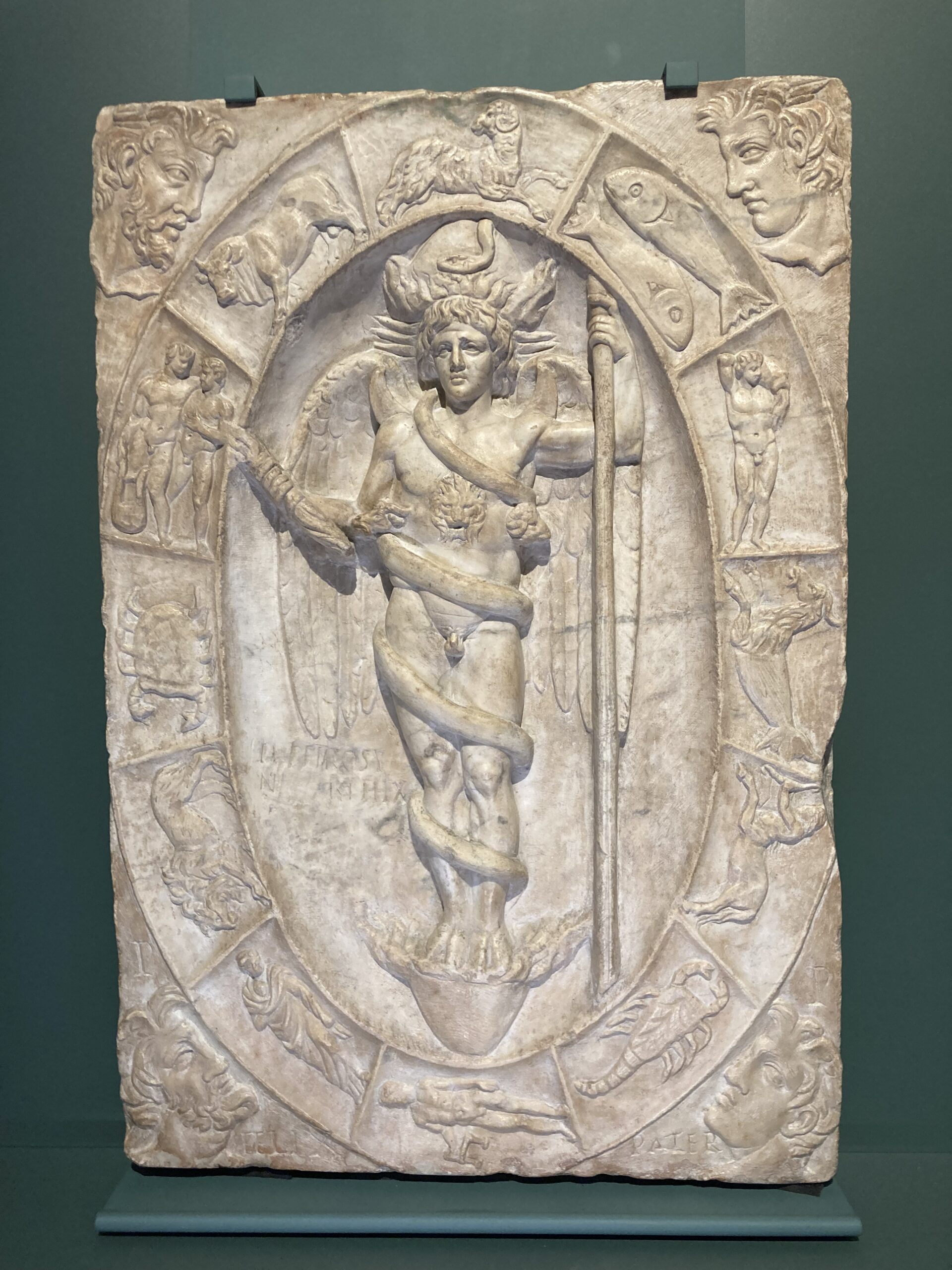
In the richly symbolic world of late antiquity, the Roman relief sculpture housed in the Galleria Estense in Modena, Italy, offers a captivating glimpse into the syncretic religious landscape of the 2nd century AD. This intricate relief brings together two enigmatic deities—Mithraic Aion and Orphic Phanes—whose fusion reflects a profound cosmological vision. Aion, central to Mithraic mystery cults, embodies boundless time and eternity, often depicted encircled by the zodiac, signifying the cyclical nature of existence. Phanes, a radiant, primordial god of light and creation in Orphic tradition, emerges from the cosmic egg, symbolizing the birth of order from chaos. The pairing of these figures on a single relief not only highlights the cross-pollination of Eastern and Hellenic religious ideas within the Roman Empire but also reveals a deep fascination with the mysteries of time, origin, and divine illumination.
Let’s explore the ‘what’, and the ‘how’ of this amazing Roman relief sculpture by posing some questions!
What does the figure of Aion represent in the context of Mithraic iconography, and how does his symbolism reflect the cosmological themes of Mithraism? Aion, in the context of Mithraism, is a mysterious and symbolic deity associated with eternal, cyclical time and the cosmos. While not a central figure in the Mithraic mysteries, he appears in some Mithraic iconography, most notably as a lion-headed figure entwined by a serpent, often standing on a globe and surrounded by zodiac symbols. This image represents cosmic time, the eternal cycle of the heavens, and possibly the control of celestial forces. Though not named explicitly in surviving texts, this figure is often identified as Aion, drawing parallels with the Greek personification of time, the Persian god Zurvan, and even with Gnostic aeons. Aion’s presence in Mithraism underscores the religion’s deep cosmological and esoteric focus, blending influences from Greco-Roman, Persian, and later philosophical traditions into a symbolic representation of the eternal and mysterious forces that govern the universe.
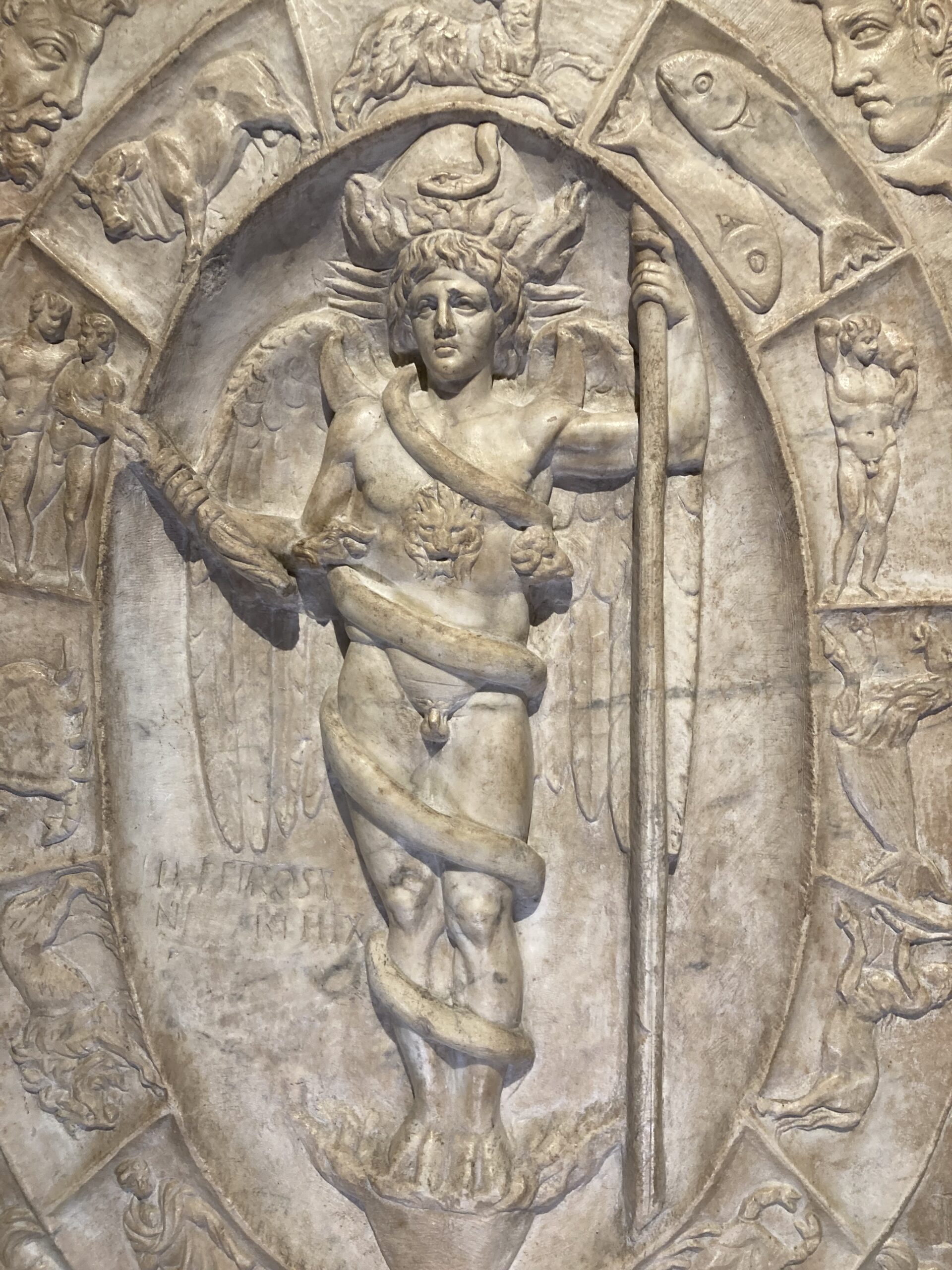
What does the figure of Phanes represent in the context of Orphic iconography, and how does his symbolism reflect the cosmological themes of Orphism? In the context of Orphic iconography, Phanes represents the primordial god of creation, light, and life, embodying the emergence of the cosmos from a state of chaos. He is often depicted as a radiant, androgynous figure, sometimes with wings, surrounded by zodiac symbols, and entwined by a serpent, much like the later images of Aion. In Orphic cosmology, Phanes is the first-born deity who emerges from the cosmic egg, breaking it open to release the ordered universe. He is the source of all gods and beings, radiating divine intelligence and life into the cosmos. His symbolism reflects key Orphic themes such as rebirth, cosmic order, and divine light, and his role as a creator positions him at the center of a spiritual narrative in which the soul seeks to return to its divine origin. Phanes illustrates the Orphic belief in a hidden, mystical structure underlying the universe, one governed by divine reason and illuminated by sacred knowledge.
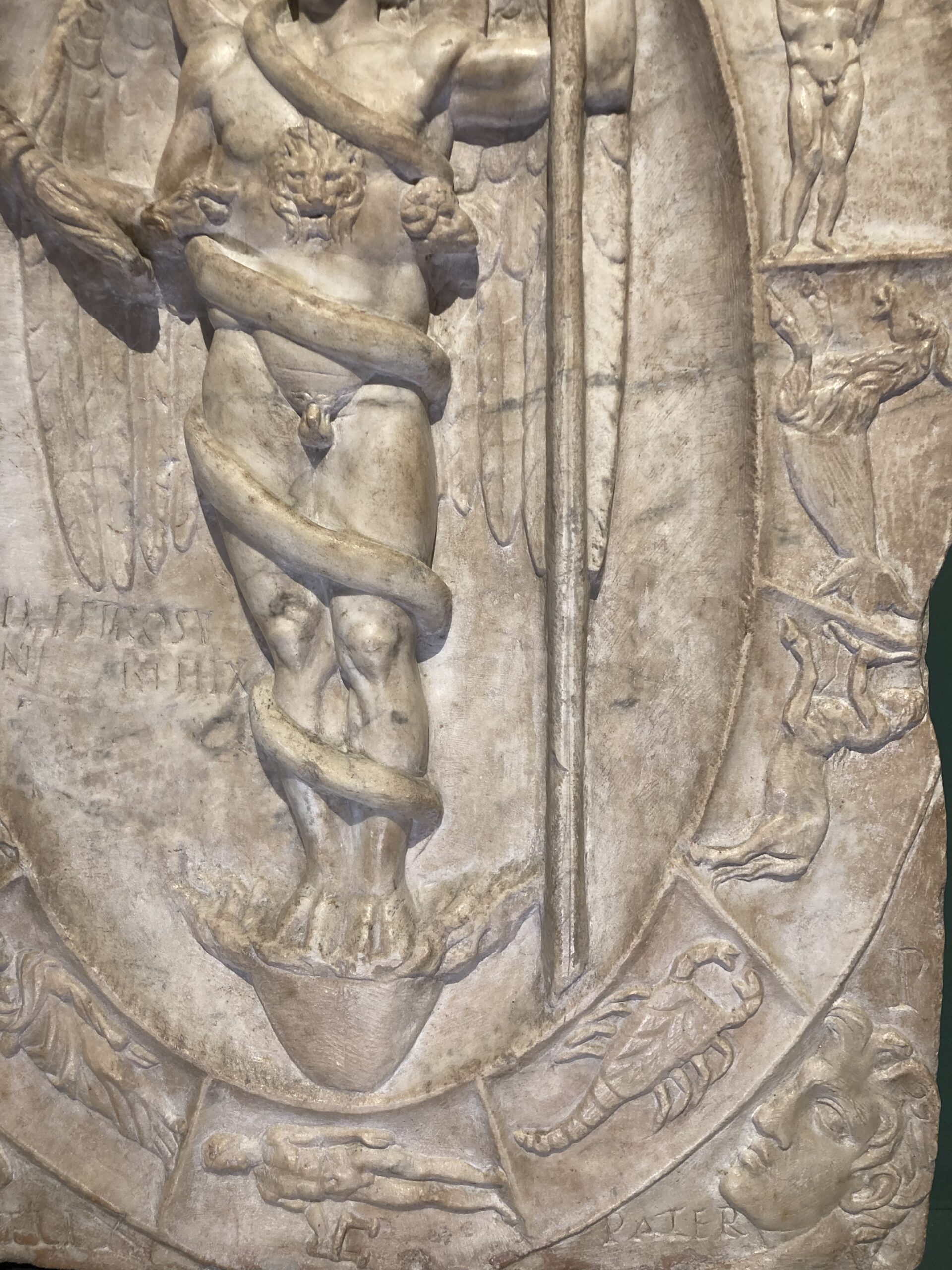
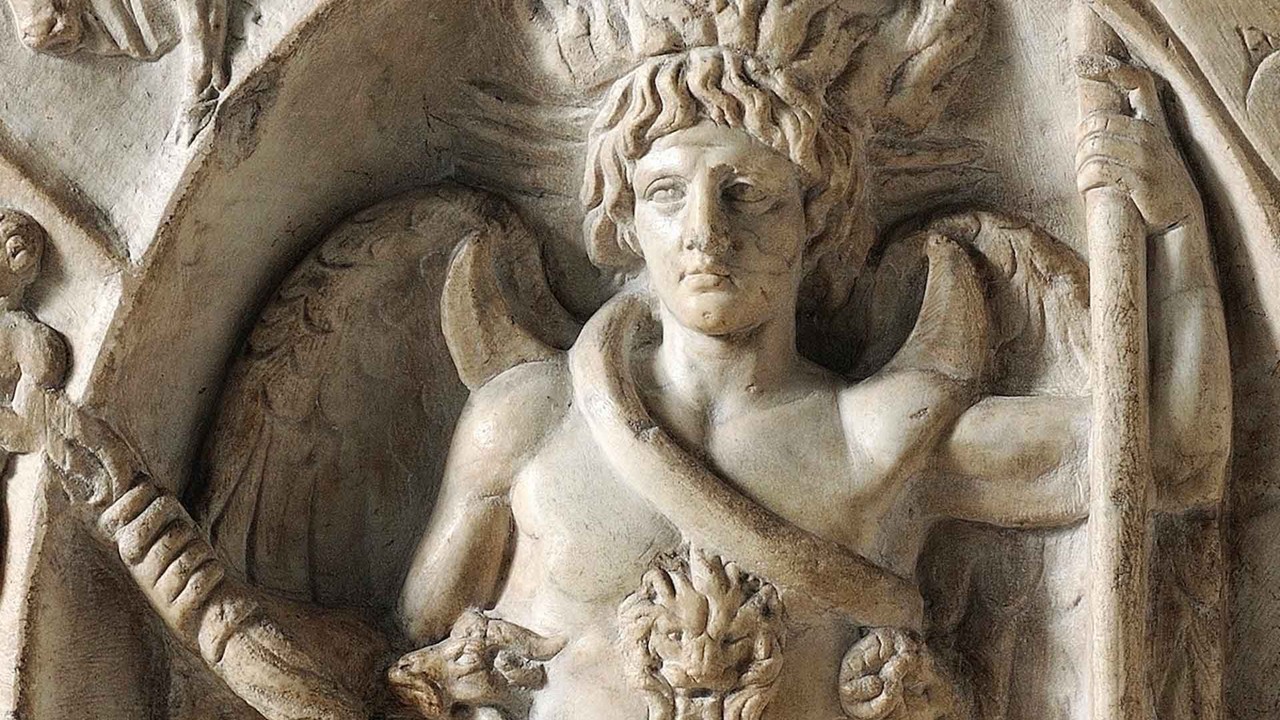
How does the Modena relief of Aion/Phanes visually represent the cosmological and theological concepts of time, creation, and divine order in Roman mystery religions? The Roman relief sculpture from the second quarter of the second century AD, housed in the Galleria Estense in Modena, presents a richly symbolic and cosmologically charged depiction of a deity identified with Aion, Phanes, Chronos, or Eros—various names for a single primordial figure associated with cosmic time, creation, and divine light. At the center stands a radiant, naked youth whose powerful presence merges multiple divine attributes. He holds a thunderbolt in his right hand and a long staff in his left, suggesting authority over both cosmic order and divine revelation. His hoof-shaped feet rest on an upturned cone, half of a cosmic egg, from which flames burst—symbolizing the act of creation. A matching, flame-emitting cone rises above his five-rayed, curly-haired head, reinforcing the theme of birth from chaos. Encircling his body in four spirals is a serpent, its head emerging above the flames—an ancient symbol of eternity, rebirth, and cosmic continuity. The figure’s wings, lion’s head chest mask, and emerging animal heads (a ram and a buck) further emphasize his fusion of natural, divine, and astrological forces. The crescent moon behind his shoulders adds a lunar dimension, balancing the solar imagery of fire and rays.
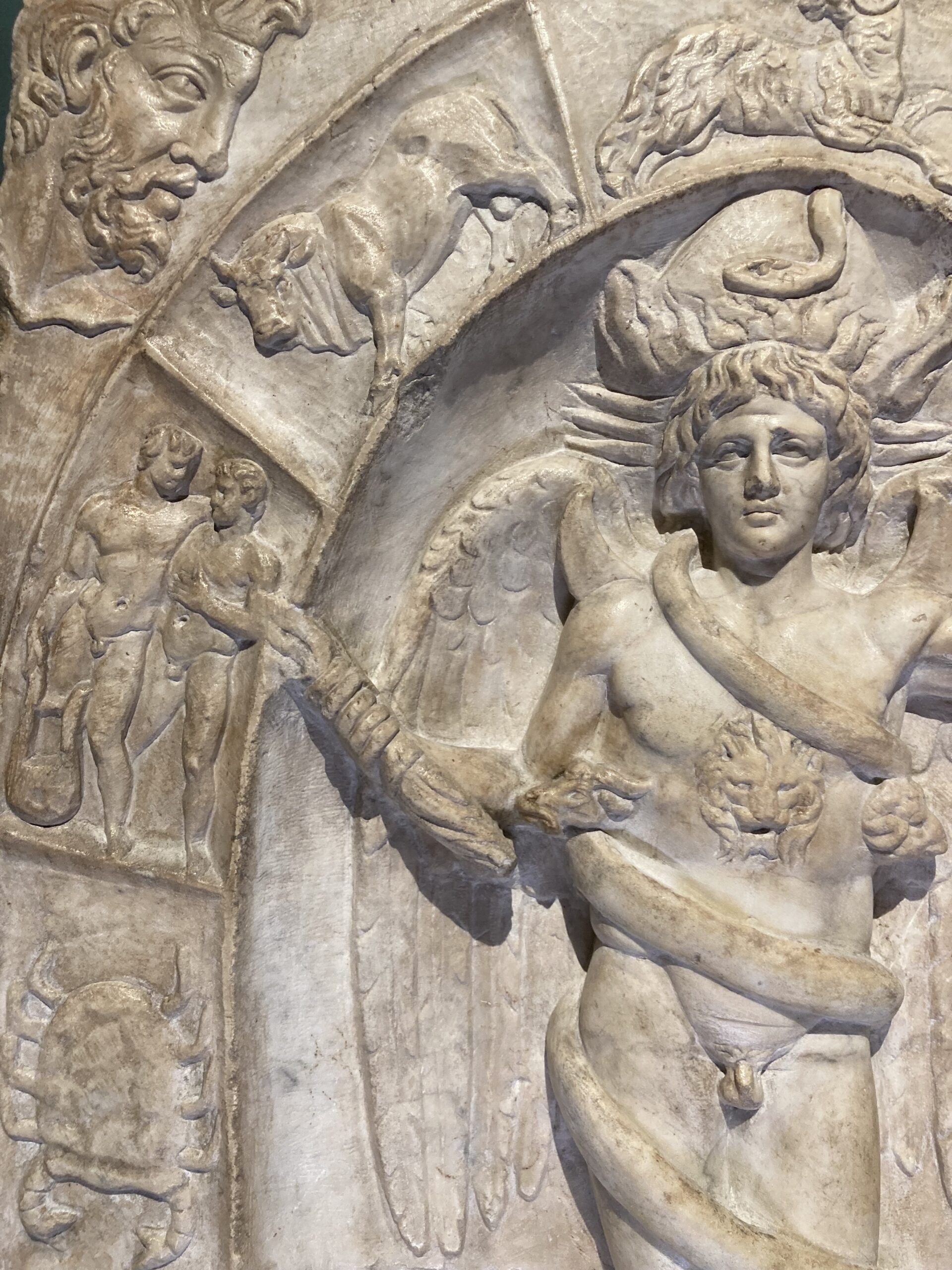
This figure is enclosed within an elliptical zodiacal band, divided into twelve sections, each containing a zodiac sign, beginning with Aries above the deity’s head and continuing counterclockwise through the signs to Pisces. Each sign is carefully personified—for instance, Gemini are shown embracing, with one playing a lyre, while Aquarius is represented as a naked youth pouring water from an amphora. The full zodiac, surrounding the god, positions him at the center of cosmic time and astral influence, underscoring his identity as a divine force who governs the heavens and the passage of time. In each corner of the relief, the four winds are personified—Zephyrus, Notus, Boreas, and Eurus—contributing to the all-encompassing cosmological vision. An inscription dedicates the sculpture to Felix and Euphrosyne, though her name was later partially erased, likely due to the Mithraic ban on female initiates. This relief encapsulates the esoteric worldview of late Roman religious thought, where divine creation, astrological order, and mystery cult symbolism intertwine in a single, intricate visual theology.
From fire and serpent, time itself takes form—Aion-Phanes rises, eternal guardian of the stars and the spark of creation.
For Student Activities inspired by the amazing Roman relief sculpture of Aion-Phanes in Galleria Estense in Modena, please… Check HERE!
Bibliography: Aion by Doro Levi, Hesperia: The Journal of the American School of Classical Studies at Athens, Vol. 13, No. 4 (Oct. – Dec., 1944), pp. 269-314 (46 pages) https://www.jstor.org/stable/146699?read-now=1&seq=42#page_scan_tab_contents and https://gallerie-estensi.beniculturali.it/en/collections/works-of-art/#/dettaglio/821254_Aion/Phanes%20all’interno%20dello%20zodiaco and https://www.tertullian.org/rpearse/mithras/display.php?page=cimrm695